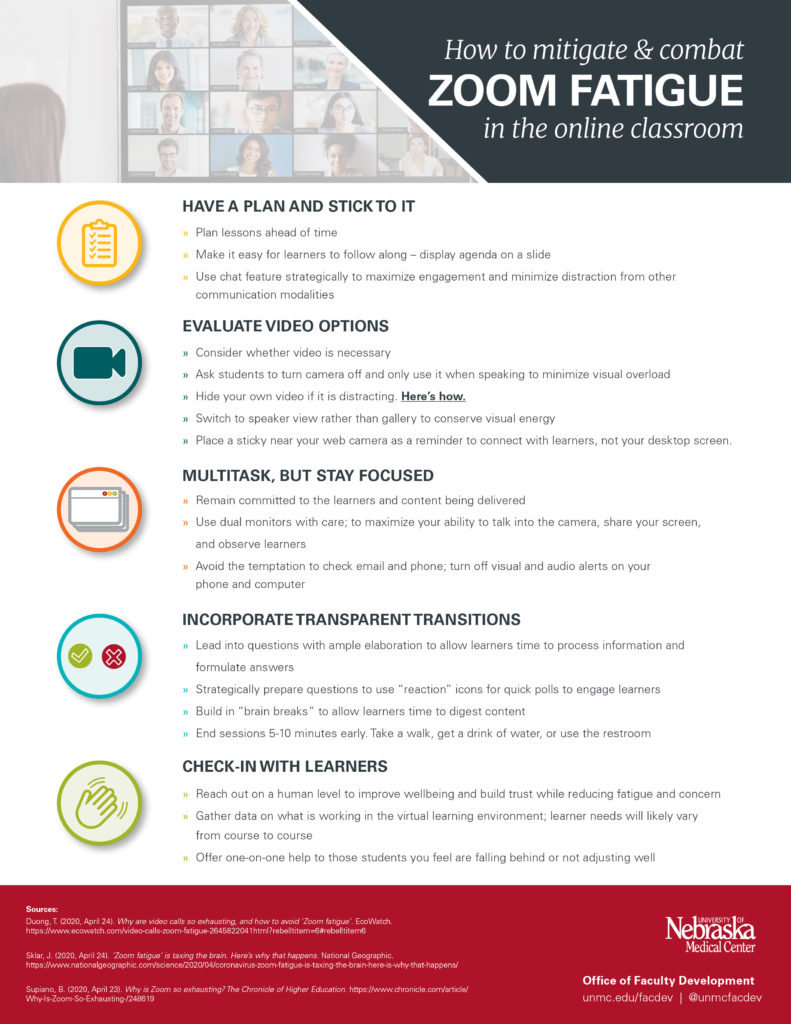Zoom is the ideal solution for synchronous teaching when in-person classes are not a possibility, however, there is an increased awareness surrounding the fatigue associated with the virtual realm. Video conferencing has become a stand-in for most interactions that would normally take place in-person. Many have used it in hopes of replicating typical interactions, but in turn, it has created a new level of exhaustion that is plaguing both learners and educators alike.
Even when humans are silent, we are communicating through non-verbal skills that are so ingrained in our nature we are often unconscious of their existence in our daily interactions. These non-verbal cues are inhibited in a group video setting, where body language is limited and poor video quality can diminish the accuracy of facial expressions. Additionally, because video software capacity is aimed at single audio stream, video chats can feel less collaborative and slower-paced, while participants wait for their turn to speak. It is also important to recognize many individuals are using video platforms regularly, often jumping from session to session.
These are just a handful of factors contributing to an unfamiliar level of fatigue. So what steps can educators take to help themselves, and their learners, feel less exhausted?
Below are some tips for combating and mitigating “Zoom fatigue” in online learning environments (or view this downloadable infographic):

Have a Plan and Stick to it
- Plan out each lesson ahead of time. Knowing what to expect will ease the stress of the students and in turn, the educator. Share the agenda on a slide to make it easy for learners to follow along and anticipate the time commitments.
- Use the chat feature at strategic times, to maximize benefits of engagement and minimize potential distractions from a dual (and potentially competing) communication modality.
Evaluate Video Options
- Consider whether or not video is necessary. If not, ask students to join the class with the camera on and turn it off when class begins to minimize visual overload. Encourage students to use video when speaking.
- If you are distracted by your own video, hide it. Constantly assessing your actions can be exhausting. Hiding your video will allow others to see you, but eliminate expending too much energy into monitoring your non-verbal cues. Here’s how to hide your video.
- If video is necessary, switch to speaker view rather than gallery. Focusing on one individual is more natural and will conserve visual energy.
- Place a sticky note or another call-out near your web camera as a reminder to connect with learners, not your desktop screen.
Multitask, but Stay Focused
- Multitasking is unavoidable when presenting, especially in the digital realm. Remain committed to the learners and content being delivered. Looking at a second screen while teaching negatively impacts student perceptions of attention. Use dual monitors with care, to maximize your ability to talk into the camera, share your screen, and observe learners.
- Avoid the temptation to check email or alerts. Dropping focus, even for a split second, and trying to pick back up again takes a mental toll. Turn off audio and visual notifications on your computer and cell phone; encourage students to do the same. Simply seeing or hearing notification alerts can trigger anxiety and prompt a desire to shift attention.
Incorporate Transparent Transitions
- Lead into questions with ample elaboration to allow learners time to process information and formulate answers without a draining dead silence. Strategically prepare some questions to use “reaction” icons for quick polls to engage learners. Build in “brain breaks” to allow learners time to digest content.
- End sessions 5-10 minutes early. This will allow you and the learners to take a break before the next engagement to allow the brain to switch gears. Take a walk, get a drink of water, or use the restroom as you typically would in between classes and meetings.
Check-in with Learners
- Whether it is before, during, or after the video call, be sure to check in on your learners. Make an extra effort to reach out on a human level, this will not only improve wellbeing, but it will also build trust while reducing fatigue and concern.
- Gather data on what is working well in the virtual learning environment. The needs of learners likely will vary from course to course. Offer one-on-one help to those students you feel are falling behind or not adjusting well to the new learning environment.
Sources:
Duong, T. (2020, April 24). Why are video calls so exhausting, and how to avoid ‘Zoom fatigue’. EcoWatch. https://www.ecowatch.com/video-calls-zoom-fatigue-2645822041.html?rebelltitem=6#rebelltitem6
Sklar, J. (2020, April 24). ‘Zoom fatigue’ is taxing the brain. Here’s
why that happens. National Geographic.
https://www.nationalgeographic.com/science/2020/04/coronavirus-zoom-fatigue-is-taxing-the-brain-here-is-why-that-happens/
Supiano, B. (2020, April 23). Why is Zoom so exhausting? The Chronicle of Higher Education. https://www.chronicle.com/article/Why-Is-Zoom-So-Exhausting-/248619

Thanks for leeting me comment, by the way great article.